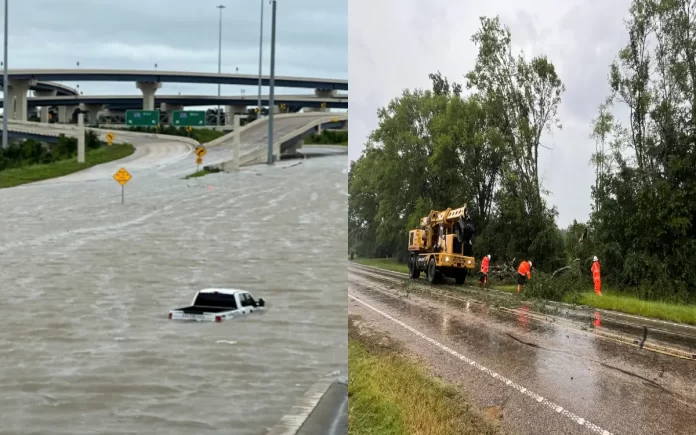At least eight people have died after Hurricane Beryl slammed into southeast Texas and Louisiana, knocking out power for nearly three million people. Beryl hit the southern United States on Monday morning as a category one hurricane but has since been downgraded to a tropical depression. Officials warned of destructive winds, up to 15 inches (38 cm) of rain, and “life-threatening” storm surges.
More than 1,100 flights were canceled at Houston’s main airport on Monday, according to FlightAware.com. PowerOutage.us reported that 2.6 million customers in Texas were without power as of Monday night, with some outages also reported in Louisiana. The storm caused at least ten deaths in the Caribbean. Also Read: Houston Zoo Submerged as Hurricane Beryl Hits Texas
Fatalities and Damage Reports
Officials reported seven deaths in Texas’s Harris and Montgomery counties, and one additional fatality in neighboring Louisiana:
- In Harris County, a 53-year-old man died after winds downed power lines and knocked a tree onto his home, causing his roof to collapse.
- In the same county, 73-year-old Maria Loredo was killed when a tree crashed through the roof of her home.
- A Houston Police Department employee, Russell Richardson, 54, drowned while attempting to drive through high water on his way to work.
- Another person died in a house fire believed to have been sparked by lightning.
- Three people died in Montgomery County, including a man killed by a falling tree while driving a tractor and two homeless individuals who were killed when a tree fell on their tent.
In Louisiana, a woman was killed in the town of Benton when a tree fell on her home. Sustained wind speeds in the Houston area reached 75 mph (120 km/h), with gusts up to 87 mph as the storm struck.
Ongoing Risks and Response Efforts
Beryl is expected to continue losing strength as it moves north-northeast, but flash flooding and heavy rain remain a risk. The National Weather Service (NWS) warned of potential tornadoes in Texas, Louisiana, and Arkansas on Monday night, with the risk shifting to Missouri, Tennessee, Kentucky, Illinois, Indiana, and Ohio on Tuesday.
The ports of Corpus Christi, Houston, Galveston, Freeport, and Texas City were closed. Over 2,500 emergency responders, including members of the Texas National Guard, have been mobilized to deal with Beryl’s aftermath.
Power Restoration Efforts
Houston’s primary electricity provider, CenterPoint Energy, aims to restore power to one million customers who experienced outages by the end of Wednesday. The company has so far restored power to over 425,000 customers, with 1,839,216 still without power late Monday. The total number of customers without power at the peak of the outage was 2.265 million.
CenterPoint’s efforts are bolstered by about 10,000 workers from outside the company and its own force of 1,500 workers deployed to restore electricity and reroute power around damaged lines and facilities. The company has also trucked portable generators to locations with critical needs, including a medical facility and an emergency response operation.
Historical and Environmental Context
Beryl became the earliest category five hurricane ever recorded and was one of the most powerful storms to ever hit Jamaica. The hurricane brought heavy rain to tourist hotspots in southern Mexico, including Cancún and Tulum. Exceptionally high sea surface temperatures are seen as a key factor in Beryl’s power. This is the first hurricane of the 2024 Atlantic season, but the US National Oceanic and Atmospheric Administration (NOAA) has warned that the North Atlantic could see as many as seven major hurricanes this year, up from an average of three per season.
Beryl is expected to move east across America’s central states, including Mississippi, later in the week, bypassing central and west Texas, which are currently experiencing moderate to severe drought conditions.



